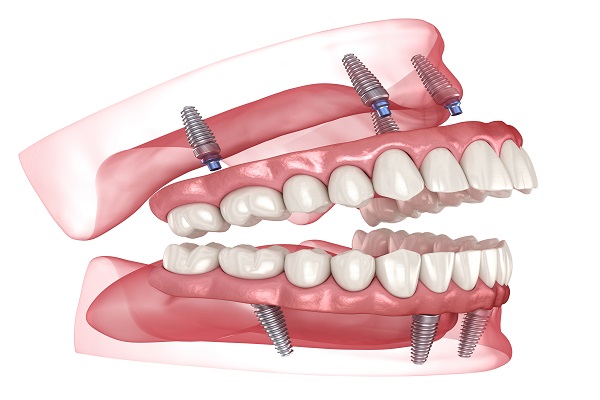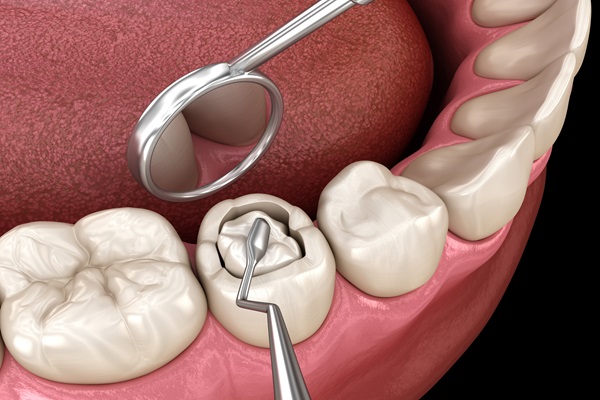How Dentists Plan the All-on-4 Procedure

Patients lose teeth for a variety of reasons, including tooth decay and trauma. The All-on-4® procedure is an option for patients who want to quickly replace a full set of missing teeth.
All-on-4® planning process
The All-on-4® procedure's name is a reference to utilizing four dental implants to support an entire upper or lower arch of teeth. Conventional dental implant procedures usually require six to eight implants. The planning process involves several steps.
1. Candidate assessment
Patients who want an All-on-4® procedure must have good oral health, be a non-smoker and be healthy enough to have surgery. The procedure may be recommended for candidates who meet one of several criteria:
- Have issues with loose dentures
- Would need a bone graft for traditional implants
- Have lost or damaged all or most of the teeth in a dental arch
- Need a cost-effective option
- Have gum disease that makes conventional implants impossible
- Have experienced dental trauma or damage to jaw muscles
Patients who are immunocompromised or have certain autoimmune diseases, such as lupus or diabetes, may not be able to have the procedure. Patients without sufficient immune function may have difficulty healing after surgery, which can prevent the osseointegration process necessary for implants to be stable.
2. Initial consultation
The dentist begins by performing a dental exam and assessing the patient's functional requirements and aesthetic preferences. The patient may ask the dentist questions about the process and other treatment options at this stage. The dentist also determines whether any additional dental work must be done before the All-on-4® procedure. Some patients may need bone grafts, treatment for gum disease, or a sinus lift.
3. Bone density assessment
All-on-4® procedures require bone that has enough quantity and quality to support the implants. Without it, the procedure is likely to fail. Dentists use technologies such as 3D cone beam computed tomography scans to determine whether patients have enough high-quality bone to support the implant procedure.
All-on-4® frequently asked questions
These are some of the commonly asked questions you may want to review with your dentist during the planning stages.
What are the benefits of the procedure?
Many patients can have an entire set of missing teeth replaced in a single day and with only one surgery. The procedure requires fewer implants than traditional implant-supported denture or bridge procedures. Most patients do not require bone grafting. The angled placement of the implants is less invasive than traditional implants. The implants keep replacement teeth secure in the mouth, unlike dentures that may slide around. Implants help prevent jawbone deterioration. The procedure is usually more cost-effective than replacing teeth individually.
What are the drawbacks of the procedure?
Patients must have a high level of high-quality bone to keep the implants in place. Implants cannot be inserted in the molar area of the mouth because the bite force is too high. Unlike dentures, there is no way to test how you like the look and feel before having the procedure. Some patients experience complications from the surgery.
How long does it take to recover from the procedure?
The recovery time is usually three to eight months for traditional implants, but many patients recover more quickly with this procedure. However, results vary by patient.
How long do the implants last?
Implants can last as long as 20 years or more. One study published in the Journal of the American Dental Association found that over 93% of All-on-4® implants lasted at least 10 years.
Do the implants require a special cleaning routine?
While you are recovering from the surgery, you may clean your mouth by gently rinsing it with saltwater. Once healing is complete, you can resume your regular oral hygiene routine. Brush your teeth twice daily and floss once per day. Visit your dentist for regular cleanings and checkups.
How long does the procedure take?
The procedure takes about two to four hours per arch for most patients. Most people can resume work and other activities within one to two days.
Are there foods I will not be able to eat after the procedure?
Most patients can eat most foods immediately after the procedure. However, your dentist may suggest you not consume hard or brittle foods for 10 to 12 weeks after your surgery.
Conclusion
The All-on-4® procedure is an option for replacing missing teeth that may have advantages for some patients. If you are interested in the procedure, you must be assessed by a dentist to determine whether you are a candidate.
Request an appointment here: https://www.emergencydentistinorlando.com or call Maitland Square Dentistry at (407) 337-1112 for an appointment in our Maitland office.
Check out what others are saying about our dental services on Yelp: All-on-4 in Maitland, FL.
Related Posts
Dental Implants are titanium posts placed into the jawbone to serve as the roots of replacement teeth. They are often the most highly recommended teeth replacement solution due to the unique benefits that they provide over alternative solutions, such as removable dentures and fixed bridges.The three primary options that patients have after they lose one…
For those who severely damage or lose a permanent tooth, dental implants can restore the appearance and function of a healthy smile. This option produces a durable and more natural-looking replacement than other alternatives, such as crowns or bridges. While the treatment process can be lengthy, most patients find they can return to a normal…
Gum disease, if left untreated, often results in tooth loss, leaving many patients to wonder if they can get dental implants. Even gum disease patients who do not develop the advanced form of the disease, known as periodontitis, may want to replace missing or decayed teeth with implants. Is this possible, or will unhealthy gums…
For many people, dental implants are life-changing, as they drastically improve the appearance of the smile and increase overall comfort and function. That said, the process of installing implants is invasive, requiring several surgeries. As with any surgery, proper care post-implantation is key to preventing infection and ensuring the procedure’s success.Any area of the body…


